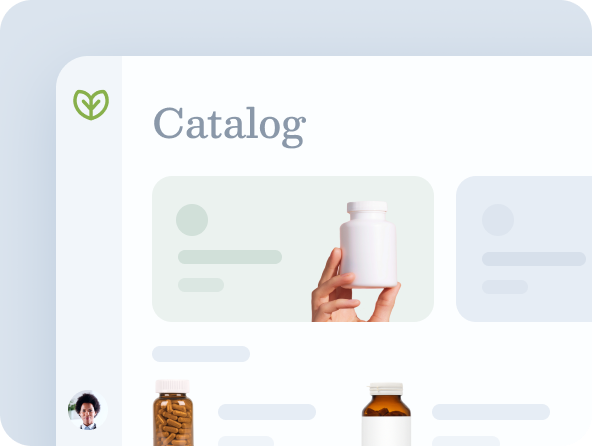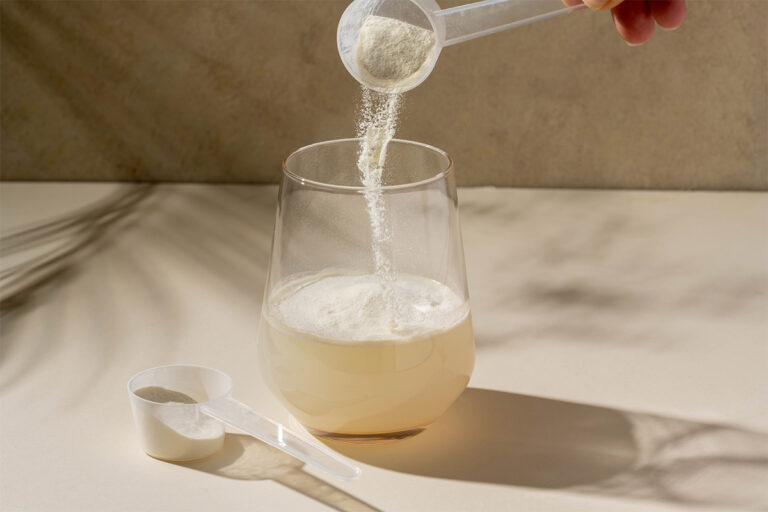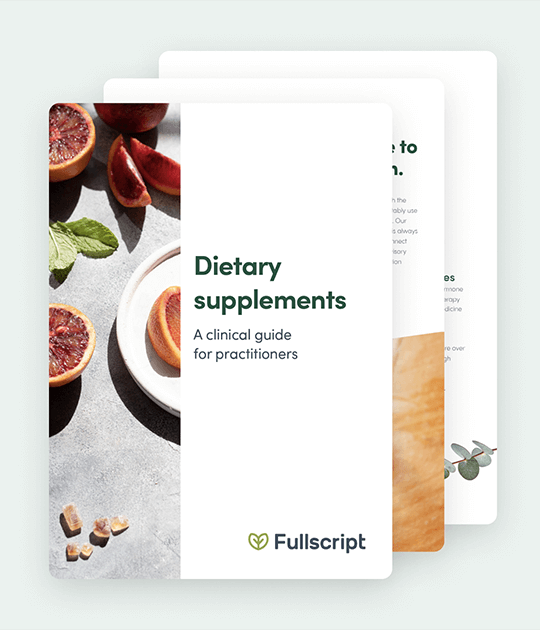If you have a clogged pipe in your kitchen, any plumber will tell you that it can eventually lead to more serious problems. The same is true for your vascular system—that complex network of arteries, veins, and capillaries that transport oxygen-rich blood throughout your body.
One of the key players in this network are your arteries. As the largest of all the blood vessels, your arteries do the heavy lifting of bringing blood to and from the heart and carrying it to the smaller blood vessels so it can nourish all of your cells and tissues. However, certain conditions, unhealthy lifestyle habits, and the natural aging process can compromise the health of your arteries. (18)(26)
Treat, prescribe, and dispense supplements for cardiovasvular health
Try Blood Pressure Support Protocol
What to Know About Your Arteries: Arteries 101
While many people think of their vascular system as a simple highway that transports blood throughout the body, it’s actually made up of two independent pathways—cardiopulmonary and systemic—that work in concert to bring blood to your cells and remove cellular waste. (13)
Arteries in the Cardiopulmonary Pathway
Your cardiopulmonary pathway circulates blood from the heart to the lungs and back again via two main coronary arteries that branch out into smaller arteries. The left main coronary artery (LMCA) supplies blood to the left side of the heart. Two arteries, the left anterior descending artery and the circumflex artery, branch off the LMCA to supply blood to the front and back of the left side of the heart.
The right coronary artery (RCA) supplies blood to the right ventricle and the right atrium, as well as the sinoatrial and atrioventricular nodes, which regulate your heart rhythm. The RCA branches out into smaller arteries that supply blood to the middle of the heart. (28)
Arteries in the Systemic Pathway
While the cardiopulmonary system keeps your heart supplied with blood, the systemic pathway is made up of a vast network of arteries that supply oxygen-rich blood to the rest of your body. (7) While the aorta is the body’s primary artery, other major arteries include the:
- Brachial artery, the major artery in the upper arm
- Carotid artery, which supplies the head and neck with blood
- Femoral artery, which delivers blood to the thigh
- Iliac arteries, which consist of three arteries in the pelvis
- Popliteal artery, which furnishes blood to the lower leg
- Pulmonary artery, which carries blood from the right ventricle of the heart to the lungs
- Radial artery, which supplies blood to the forearm
- Subclavian arteries, which bring blood from the base of the neck to the brain
- Vertebral artery, which provides blood to the upper spinal cord, brainstem, and cerebellum (1)
Do You Have Clogged Arteries?: Factors that Cause Plaque Buildup
While this complex system is incredibly efficient, damage from factors like inflammation, cholesterol oxidation, or calcium deposits can trigger plaque buildup inside your arteries. Over time, this can narrow and stiffen arteries and reduce blood flow, a condition known as arterial disease or atherosclerosis. This can increase the risk of heart attack or stroke. (5)
Did you know? Damage to the arteries that feed the heart can result in coronary artery disease (CAD). (8)

Factors that Can Damage Arteries
There are a number of things that can damage the interior of your arteries (the endothelial lining) and contribute to plaque buildup. While some, like age or a family history of heart disease, are factors beyond your control, others, like those listed below, are factors you may be able to improve with supplements and lifestyle changes:
- Chronic inflammation (16)
- Cholesterol oxidation (17)
- Diabetes or prediabetes (10)(15)
- Diet high in processed foods (31)
- Hypertension (27)
- Lack of physical activity https://pubmed.ncbi.nlm.nih.gov/25174928/
- Overweight or obesity (35)
- Smoking or chronic exposure to second-hand smoke (30)(34)
Did you know? As your body ages, your arteries lose some of their elasticity and become smaller and less pliable. This causes the heart to work harder to transport blood throughout the body. (14)
5 Supplements to Promote Healthy Arteries
Adopting a heart-healthy diet and improving your cardiovascular fitness with regular exercise is a good first step toward healthier arteries. In addition, the following 5 supplements can also play a key role in preventing arterial damage and improving blood flow.
1. Citrus Flavonoids
The peel and seeds of citrus fruits contain antioxidant-rich compounds called flavonoids. Flavonoids are responsible for the vibrant colors in fruits and vegetables, including citrus fruits. Studies have found that citrus flavonoids can support healthy arteries by reducing the risk of oxidation and inflammation. (25) These colorful antioxidants have also been shown to improve endothelial dysfunction, an indication of damaged arteries. (21)

2. Garlic
Garlic has long been linked to a healthy cardiovascular system, and for good reason. Research suggests that this pungent herb helps prevent the oxidation of low-density lipoprotein (LDL, the “bad” cholesterol), reduces the buildup of calcium deposit in arteries, lowers blood pressure, and prevents inflammation. (12)(19)(29)(33) One study that appeared in the Journal of Nutrition found that one unique form of garlic—aged garlic extract—was able to reduce non-calcified or “low-attenuation” plaque in arteries. (23) This soft plaque is especially dangerous because it is unstable and poses a high risk of rupturing. (6)
Another recent study suggests that pairing garlic with lemon juice may improve cholesterol levels and lower blood pressure. During the study of 112 people with high cholesterol levels, those who took a daily dose (20 g, or slightly more than six cloves) of fresh garlic plus one tablespoon of lemon juice experienced a significant drop in LDL and total cholesterol, as well as fibrinogen, a protein involved in blood clotting. The researchers also noted a marked reduction in both systolic and diastolic blood pressure. (4)
3. Omega-3 Fatty Acids
Supplementing with omega-3 fatty acids from fish, specifically docosahexaenoic acid (DHA) and eicosapentaenoic acid (EPA), has been shown to protect blood vessels. Studies show that these omega-3s help lower high blood pressure and triglyceride levels. They also modulate many of the mechanisms involved in the development of atherosclerosis, including inflammation, blood clotting, and platelet aggregation (stickiness) that can reduce blood flow. (32)
4. Vitamin C
Studies show that vitamin C supplementation can reduce the risk of heart disease and improve artery health in several ways. In one review of 44 randomized controlled trials that appeared in the journal Atherosclerosis, vitamin C supplementation was found to improve endothelial function in people with pre-existing atherosclerosis, heart failure, or diabetes. (3) Another meta-analysis of 13 studies found that supplementing with at least 500 mg of vitamin C daily reduced some risk factors that contribute to atherosclerosis. When the data was pooled, researchers found that taking vitamin C reduced LDL by 7.9 mg/dL and blood triglycerides by 20.1 mg/dL. However, the researchers also noted that it takes at least four weeks to experience these results. (24)
5. Vitamin K
There are two primary forms of vitamin K: vitamin K1 (phylloquinone) and vitamin K2 (menaquinone). While a diet high in leafy greens can provide plenty of vitamin K1, this form of the nutrient isn’t well-absorbed by the body. (11) Studies, however, have found that one form of vitamin K2 known as MK-7 can be absorbed by the body, helping prevent the accumulation of calcium deposits in arteries. It does this by shuttling calcium out of arteries and into bones where it belongs. (9) Vitamin K2 also improves blood pressure and other markers of artery health. One study published in the Journal of the American Society of Hypertension looked at 60 kidney transplant patients with low vitamin K levels. They found that supplementing with 360 mcg of K2 for eight weeks improved both blood pressure and arterial stiffness. (22)
Did you know? A diet filled with calcium-rich food can lower your overall risk of atherosclerosis, but research suggests that the long-term use of calcium supplements may increase the risk of calcification inside arteries. (2)
The Bottom Line: Healthy Arteries Are Essential
Healthy arteries are essential for ensuring that oxygen-rich blood reaches all your cells and tissues. Paired with heart-healthy habits, the supplements listed above may help prevent future damage to your arteries that could lead to a heart attack or stroke. It’s wise to check with your healthcare professional to tailor a cardiovascular wellness plan that best meets your needs, especially if you’ve been diagnosed with atherosclerosis or other cardiovascular disease.
- Anatomy, blood vessels. (2020). StatPearls. NCBI Bookshelf. www.ncbi.nlm.nih.gov/books/NBK470401/
- Anderson JJB, Kruszka B, Delaney JAC, et al. (2016). Calcium intake from diet and supplements and the risk of coronary artery calcification and its progression among older adults: 10-year follow-up of the multi-ethnic study of atherosclerosis (MESA). Journal of the American Heart Association. 5(10).
- Ashor AW, Lara J, Mathers JC, et al. (2014). Effect of vitamin C on endothelial function in health and diease: A systematic review and meta-analysis of randomized controlled trials. Atherosclerosis. 235(1), 9-20.
- Aslani N, Entezari MH, Askari G, et al. (2016). Effect of garlic and lemon juice mixture on lipid profile and some cardiovascular risk factors in people 30-60 years old with moderate hyperlipidaemia: A randomized clinical trial. International Journal of Preventive Medicine. 7, 95.
- Atherosclerosis. (2018). National Institutes of Health, National Heart, Lung, and Blood Institute. https://www.nhlbi.nih.gov/health-topics/atherosclerosis
- Chen, Y., Huang, A.L., Kyaw, T.S., Bobik, A., & Peter, K. (2016). Atherosclerotic plaque rupture. Arteriosclerosis, Thrombosis, and Vascular Biology, 36, e63-e72.
- Circulatory pathways. National Cancer Institute. National Institutes of Health. https://training.seer.cancer.gov/anatomy/cardiovascular/blood/pathways.html
- Coronary Artery Disease (CAD). (2019). Centers for Disease Control and Prevention. https://www.cdc.gov/heart-disease/about/coronary-artery-disease.html
- DiNicolantonio JJ, Bhutani J, O’Keefe JH. (2015). The health benefits of vitamin K. Open Heart. 2:e000300.
- DiPino A, DeFranza RA. (2019). Insulin resistance and atherosclerosis: Implications for insulin-sensitizing agents. Endocrine Review. 40(6), 1447-1467.
- Gijsbers BLMG, Jie KSF, Vermeer C. (1996). Effect of food composition on vitamin K absorption in human volunteers. British Journal of Nutrition. 76(2), 223-229.
- Hom C, Budoff M, Luo Y. (2015). The effects of aged garlic extract on coronary artery calcification progression and blood pressure. Journal of the American College of Cardiology. 65(10 Supplement).
- How does the blood circulatory system work? https://www.ncbi.nlm.nih.gov/books/NBK279250/
- Jani B, Rajkumar C. (2006). Ageing and vascular ageing. Postgraduate Medical Journal. 82(968), 357–362.
- Katakami N. (2018). Mechanism of development of atherosclerosis and cardiovascular disease in diabetes mellitus. Journal of Atherosclerosis and Thrombosis. 25(1), 27-39.
- Koltsova EK, Garcia Z, Chodaczek G, et al. (2012). Dynamic T-cell-APC interactions sustain chronic inflammation in atherosclerosis. The Journal of Clinical Investigation. 122(9), 3114-3126.
- Lara-Guzmán OJ, Gil-Izquierdo A, Medina S, et al. (2018). Oxidized LDL triggers changes in oxidative stress and inflammatory biomarkers in human macrophages. Redox Biology. 15, 1-11.
- LaRocca TJ, Martens CR, Seals DR. (2017). Nutrition and other lifestyle influences on arterial aging. Ageing research reviews. 39, 106–119.
- Lau BHS. (2006). Suppression of LDL oxidation by garlic compounds is a possible mechanism of cardiovascular health benefit. Journal of Nutrition. 136(3 Suppl), 765S-768S).
- Laufs U, Wassmann S, Czech T, et al. (2005). Physical inactivity increases oxidative stress, endothelial dysfunction, and atherosclerosis. Arteriosclerosis, Thrombosis, and Vascular Biology. 25, 809-814.
- Mahmoud AM, Hernández Bautista RJ, Sandhu MA, et al. (2019). Beneficial effects of citrus flavonoids on cardiovascular and metabolic health. Oxidative Medicine and Cellular Longevity. 2019, 5484138.
- Mansour AG, Hariri E, Daaboul Y, et al. (2017). Vitamin K2 supplementation and arterial stiffness among renal transplant recipients—a single-arm, single-center clinical trial. Journal of the American Society of Hypertension. 11(9), 589-597.
- Matsumoto S, Nakanishi R, Li D, et al. (2016). Aged garlic extract reduces low attenuation plaque in coronary arteries of patients with metabolic syndrome in a prospective randomized double-blind study. The Journal of Nutrition. 146(2), 427S-432S.
- McRae MP. (2008). Vitamin C supplementation lowers serum low-density lipoprotein cholesterol and triglycerides: A meta-analysis of 13 randomized controlled trials. Journal of Chiropractic Medicine. 7(2),48-58.
- Mulvhill EE, Huff MW. (2012). Citrus flavonoids and the prevention of atherosclerosis. Cardiovascular & Hematological Disorders Drug Targets. 12(2), 84-91.
- Najjar SS, Scuteri A, Lakatta EG. (2005). Arterial aging. Is it an immutable cardiovascular risk factor? Hypertension. 46(3), 454-462.
- Ning B, Chen Y, Wagar AB, et al. (2018). Hypertention enhancs advanced atherosclerosis and induces cardiac death in watanabe heritable hyperlipidemic rabbits. American Journal of Pathology. 188(12), 2936-2947.
- Physiology, pulmonary circulation. Lydia Boyette. https://www.ncbi.nlm.nih.gov/books/ NBK518997/
- Ried K. (2020). Garlic lowers blood pressure in hypertensive subjects, improves arterial stiffness and gut microbiota: A review and meta-analysis. Experimental and Therapeutic Medicine. 19, 1472-1478.
- Siasos G, Tsigkou V, Kokkou E, et al. (2014). Smoking and atherosclerosis: Mechanisms of disease and new therapeutic approaches. Current Medicinal Chemistry. 21(34), 3936-3948.
- Srour B, Fezeu LK, Kese-Guyot E, et al. (2019). Ultra-processed food intake and risk of cardiovascular disease: Prospective cohort study (NutriNet-Santé). BMJ. 365, 11451.
- Weitz D, Weintraub H, Fisher E, et al. (2010). Fish oil for the treatment of cardiovascular disease. Cardiovascular Review. 18(5), 258-263.
- Williams MJA, Sutherland WHF, McCormick MP, et al. (2005). Aged garlic extract improves endothelial function in men with coronary artery disease. Phytotherapy Research. 19(4), 314-319.
- Yankelevitz DF, Cham MD, Hecht H, et al. (2017). The association of secondhand tobacco smoke and CT angiographt-verified coronary atherosclerosis. JACC Cardiovascular Imagaing. 10(6), 652-659.
- Yoo HJ, Choi KM. (2014). Adipokines as a novel link between obesity and atherosclerosis. World Journal of Diabetes. 5(3), 357-363.






